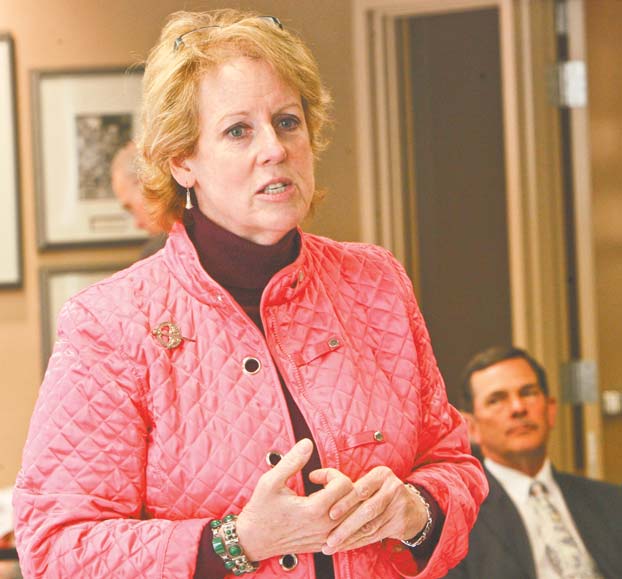Mahoning officials hear case for court consolidation

Chief Justice Maureen O’Connor of the Ohio Supreme Court presides over a meeting of local judges, court personnel and government offi cials concerning consolidation of Mahoning County’s lower courts at Youngstown State University’s Kilcawley Center. Seated behind her at Monday’s session is Judge R. Scott Krichbaum of Mahoning County Common Pleas Court.
YOUNGSTOWN
The path to consolidation of Mahoning County’s lower courts can begin with easily agreed- upon small steps, according to a consultant who studied the matter for the county bar association.
The court research consultant, Ingo Keilitz, with the Williamsburg, Va.-based National Center for State Courts, suggested Monday that the effort, which he estimated would take six years to complete, can begin with easy-to-resolve issues.
Keilitz spoke at a meeting of local judges and other court personnel and government officials in a 28-person conference-table discussion moderated by Chief Justice Maureen O’Connor of the Ohio Supreme Court at Youngstown State University’s Kilcawley Center.
Keilitz said things such as court website and scheduling consolidation; mergers of specialty courts, such as drug courts, in cases where they duplicate one another; fine- and fee-collection improvements and better performance measurement and management could be accomplished without any major cost or any need for court reorganization legislation.
Keilitz opened his presentation with more-strident rhetoric, however.
“End the stalemate of 25 years and begin consolidating the courts of Mahoning County today. It’s the right thing to do,” he urged.
The current system of seven separate locations, four for county courts and three for municipal courts, is characterized by “unequal distribution of court resources throughout the county,” he said.
His assertion was backed by an earlier presentation by Stephanie E. Hess, the top court’s case- management manager, which showed Youngstown Municipal Court with a caseload of 4,147 for each of the three full-time municipal judges in 2010, compared with 12,211 cases that year for part-time Judge David D’Apolito, who sits alone in Mahoning County Area Court in Austintown.
Full-time municipal-court judges in Ohio average between 10,000 and 12,000 cases a year per judge, Hess said.
Although the figures reported by each local court to the Ohio Supreme Court are broken down into criminal, traffic and civil categories, the top court does not report more-detailed comparisons of case complexity, judicial workload or the number of times parties appear before a judge while cases are pending, Hess acknowledged.
Judge James Lanzo of Struthers Municipal Court and Judge Elizabeth Kobly, presiding judge of Youngstown Municipal Court, said the absence of such detail makes the top court’s caseload comparisons flawed.
“With efficient case-flow management, you don’t want to have a lot of appearances,” Hess said. “You want to be able to hear a case in the most- efficient way possible, while also doing justice in that case.”
Youngstown Councilwoman Annie Gilliam, D-1st, said she was concerned a countywide consolidation of municipal and county courts might not be conducive to having racial minority-group members represented among the judges, who all are elected to their posts.
Atty. Dave Betras, county Democratic Party chairman, who sought the meeting with the chief justice, said, however, that problem could be solved under a model in which the countywide municipal court is divided into a northern division based in Youngstown and a southern division based in Canfield, with judges elected within each division.
Judge Robert Douglas of Youngstown Municipal Court currently is the county’s only black judge.
Sarah Brown-Clark, clerk of Youngstown Municipal Court, noted that another large issue eventually looms in the court- consolidation process — location and construction costs for new court facilities.
Judge Joseph Houser of Mahoning County Area Court in Boardman said he has seen no analysis of cost savings and economic benefits to be derived from consolidation.
Keilitz acknowledged he could not guarantee consolidation would produce cost savings.
Chief Justice O’Connor said she and other top court personnel were offering their services as a resource to explore lower-court consolidation. “We are not here to dictate from the top down,” she said, adding that local elected officials must make the decisions as to how the county’s lower courts should be organized.
 43
43
